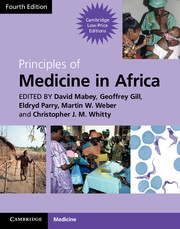Book contents
- Frontmatter
- Contents
- Contributors
- Foreword
- Section 1 Health and disease
- Section 2 Mother and child health
- Section 3 Infection: general principles
- Section 4 Major common infections
- Section 5 Bacterial infections
- Section 6 Viral Infections
- Section 7 Protozoal infections
- Section 8 Helminth infections
- Section 9 Fungal infections
- Section 10 Non-communicable diseases
- Section 11 Diseases of body systems
- 65 The heart
- 66 The lung
- 67 Blood disorders
- 68 The gut
- 69 The liver
- 70 The kidney and body fluids
- 71 Bones and joints
- 72 Endocrinology
- 73 The nervous system
- 74 The skin
- 75 The eye
- Section 12 Cancer and Palliative Care
- Section 13 Venoms and Poisons
- Index
- References
74 - The skin
from Section 11 - Diseases of body systems
Published online by Cambridge University Press: 05 March 2013
- Frontmatter
- Contents
- Contributors
- Foreword
- Section 1 Health and disease
- Section 2 Mother and child health
- Section 3 Infection: general principles
- Section 4 Major common infections
- Section 5 Bacterial infections
- Section 6 Viral Infections
- Section 7 Protozoal infections
- Section 8 Helminth infections
- Section 9 Fungal infections
- Section 10 Non-communicable diseases
- Section 11 Diseases of body systems
- 65 The heart
- 66 The lung
- 67 Blood disorders
- 68 The gut
- 69 The liver
- 70 The kidney and body fluids
- 71 Bones and joints
- 72 Endocrinology
- 73 The nervous system
- 74 The skin
- 75 The eye
- Section 12 Cancer and Palliative Care
- Section 13 Venoms and Poisons
- Index
- References
Summary
The problem in Africa
Although skin diseases do not usually threaten life, their unforgiving itching can cause misery and their unsightly appearance causes social stigmatization. In sub-Saharan Africa, skin diseases are dominated by bacterial and fungal infection and their clinical expression is often modified by HIV, which has magnified their burden. They account for approximately one-third of the burden of disease (industrialized countries ~ 15 per cent), are among the top five causes of morbidity, lead to up to 15 per cent of all attendances in peripheral health clinics, and yet more than 80 per cent do not require specialized expertise.
Most skin diseases are preventable and curable with simple, cheap and effective medication; about 90 per cent are seen by traditional healers or auxiliary health workers with very little or no dermatology training.
Dermatology differs decidedly between pigmented and white Caucasian skin. The dermatoses present differently, due to differences in colour and physical properties of the skin
Epidemiology
The pattern of skin diseases differs considerably between urban and rural areas as Grossmann emphasizes, because environment and social and economic factors are their key determinants. Rural people and the urban poor are at the highest risk of infective-parasitic diseases, which account for 60 per cent of all skin diseases, so that communicable diseases, such as scabies, pyoderma and mycotic infections, cause a massive morbidity; while onchocerciasis, filariasis and leishmaniasis are important in some areas. The rural poor also suffer through difficult access; late diagnosis delays treatment and increases disability and incapacity.
- Type
- Chapter
- Information
- Principles of Medicine in Africa , pp. 779 - 810Publisher: Cambridge University PressPrint publication year: 2013



